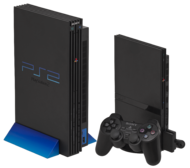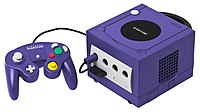History of video game consoles (sixth generation)

The sixth generation of video game consoles began on November 27, 1998. Also known as the last non-motion control gaming era, the sixth generation is also called the 128-bit generation. The sixth generation began with the release of the Dreamcast in Japan. This generation included the game consoles of the PlayStation 2, Nintendo GameCube and Microsoft Xbox. The Dreamcast was discontinued in 2001, but sold games until 2007. The GameCube was discontinued in 2007. The Xbox sold its last games in 2008, but didn't get discontinued until 2009. The PlayStation 2 was discontinued in 2013, which ended the sixth generation.
Game systems
[change | change source]Comparison
[change | change source]| Name | Dreamcast | PlayStation 2 | GameCube | Xbox |
|---|---|---|---|---|
| Logo |  |
 |
||
| Manufacturer | Sega | Sony Computer Entertainment | Nintendo | Microsoft |
| Image(s) | 
|

|

|

|
| An NTSC Dreamcast console, controller and VMU. The logo on PAL consoles was blue instead of orange. | Left: An original model PlayStation 2 Right: A slimline PlayStation 2 with DualShock 2 controller and memory card. |
An indigo GameCube and controller | An Xbox console and "Type-S" controller | |
| Launch prices | US$199.99[1] GB£199.99[1] |
US$299.99 GB£299.99 |
US$199.99 GB£129.99[2] €199.99[2] |
US$299.99 GB£299.99 €214.99 |
| Best-selling game | Sonic Adventure, 2.5 million (as of June 2006)[3] | Grand Theft Auto: San Andreas, 19 million shipped (as of April 30, 2008)[4] | Super Smash Bros. Melee, 7.09 million (as of March 10, 2008)[5] | Halo 2, 8 million (as of May 9, 2006)[6][7] |
| Release date | ||||
| Discontinued | March 30, 2001[8] | JP: December 28, 2012[9]
WW: January 4, 2013[10] |
2007[11] | |
| Accessories (retail) |
|
|
||
| CPU | 200 MHz SuperH SH-4 | 294 MHz MIPS "Emotion Engine" | 485 MHz PowerPC "Gekko" | 733 MHz x86 Intel Celeron/PIII Custom Hybrid |
| GPU | 100 MHz NEC/VideoLogic PowerVR CLX2 | 147 MHz "Graphics Synthesizer" | 162 MHz ATI "Flipper" | 233 MHz Custom Nvidia NV2A |
| RAM | Main RAM 16 MB SDRAM Video RAM 8 MB Sound RAM 2 MB |
Main RAM 32 MB RDRAM Video RAM 4 MB Sound RAM 2 MB |
Main RAM 24 MB 1T-SRAM, 16 MB DRAM Video RAM 3 MB embedded 1T-SRAM |
64 MB unified DDR SDRAM |
| Optical media | CD, 1.2 GB GD-ROM | DVD, CD | GameCube game disc | DVD, CD |
| Video outputs | VGA (RGBHV), SCART (RGBS), s-video, composite | Component/d-terminal (YPBPR), VGA (RGBS; progressive scan games/PS2 Linux only), SCART (RGBS), s-video, composite | Component/d-terminal (YPBPR), SCART (RGBS; PAL consoles only), s-video (NTSC consoles only), composite | component (YPBPR), SCART (RGBS), S-Video, composite |
| Online service | Sega Net (2000–2002), Dreamarena (2000-2003) (can still be played using various private servers) | Non-unified service (2002–present), XLink Kai (2003-present) | Non-unified service (2003-2009) (can still be played using various private servers), XLink Kai (2003-present) | Xbox Live (2002–now) XLink Kai (2003-present) |
| Backward compatibility | No | PlayStation | Game Boy, Game Boy Color, Game Boy Advance (with Game Boy Player) | No |
| System software | SegaOS, Windows CE, KallistiOS | Proprietary OS, PS2 Linux | Proprietary OS, Gamecube Linux | Xbox Music Mixer DVD Playback Kit, Xbox Linux |
| Consumer programmability | Homebrew possible via KallistiOS, Windows CE, Katana (the latter two are illegal in the homebrew community) | Yabasic software and limited Linux OS. Homebrew also possible via both modchips and softmods. | Homebrew possible via SD card adapters and SD media launchers | Via Softmods and/or modchips; Modified Windows CE 2.x, Linux |
Worldwide sales
[change | change source]| Console | Units sold |
|---|---|
| PlayStation 2 | 153.6 million (as of November 21, 2011)[12] |
| Xbox | 24 million (as of May 10, 2006)[13][14] |
| GameCube | 21.74 million (as of September 30, 2010)[15] |
| Dreamcast | 10.6 million (as of September 6, 2002)[16][17] |
Handheld game consoles
[change | change source]| Name | Game Boy Advance / Advance SP / Micro | N-Gage / QD |
|---|---|---|
| Logos | ||
| Manufacturer | Nintendo | Nokia |
| Images |   
|
 
|
| Pictured left to right: Game Boy Advance, Game Boy Advance SP, Game Boy Micro | Pictured left to right: N-Gage, N-Gage QD | |
| Manufacturer | Nintendo | Nokia |
| Release dates | Game Boy Advance:
Game Boy Advance SP:
Game Boy Micro:
|
N-Gage: October 7, 2003 N-Gage QD: May 26, 2004 |
| Discontinued | Game Boy Advance:
|
N-Gage: 2006 |
| Launch prices | GBA:
GBA SP: GB Micro:
|
N-Gage:
N-Gage QD:
|
| Media | Game Boy Advance cartridge | MultiMediaCard (MMC) |
| Best-selling game | Pokémon Ruby and Sapphire, 13 million combined (as of November 25, 2004)[18] | ? |
| Accessories (retail) |
|
|
| OS | Symbian S60 | |
| CPU | 16.8 MHz, 32-bit, ARM7TDMI with embedded memory | 104 MHz, 32-bit, RISC based on ARM9 series |
| Memory | 32 kilobyte + 96 kilobyte VRAM (internal to the CPU), 256 kilobyte WRAM (outside the CPU) | 16 megabyte RAM, 16 megabyte ROM (3.4 MB accessible for storage) |
| Interface |
|
|
| Dimensions | GBA: 144.5 × 24.5 × 82 mm (5.69 × 0.96 × 3.2 inches) GBA SP: 84 × 82 × 24.4 mm (3.3 × 3.23 × 0.96 inches) GB Micro: 50 × 10 × 17.2 mm (2 × 4 × 0.7 inches) |
N-Gage QD: 70 mm (2.8 in) (h) 134 mm (5.3 in) (w) 20 mm (0.79 in) (d) N-Gage QD: 118 mm (4.6 in) (w) 68 mm (2.7 in) (h) 22 mm (0.87 in) (d) |
| Weight |
GBA: 140 g (4.9 oz) GBA SP: 142 g (5.0 oz) GB Micro: 80 g (2.8 oz) |
N-Gage: 137 g (4.8 oz) N-Gage QD 143 g (5.0 oz) |
| Online service | N-Gage Arena | |
| Backward compatibility | Game Boy, Game Boy Color | N/A |
| Resolutions | 240 × 160 | 176 × 208 |
| Storage | 3.4 MB internal storage, MMC | |
| Battery life | GBA: 15 hours GBA SP: 10 hours continuous play with light on, 18 hours with light off GB Micro: 5 hours with top brightness and sound, 8 hours with both features on default |
N-Gage: 2 hours continuous play N-Gage QD: 4 hours continuous play |
| Units sold (all models combined) | Worldwide: 81.51 million (as of September 30, 2010) Japan: 16.96 million |
Worldwide: 3 million (as of July 30, 2007) |
Note: First year of release is the first year of the system's worldwide availability.
Other handhelds
[change | change source]-
SwanCrystal
Released in 1999, discontinued in 2003 – Japan only -
GP32
Released in 2001, discontinued around 2005 – South Korea only
- Tapwave Zodiac(2003)
- Neo Geo Pocket Color(1999)
Sales
[change | change source]| Console | Units sold |
|---|---|
| Game Boy Advance (figure includes GBA SP and Game Boy Micro) |
81.51 million[15] |
| N-Gage | 3 million[19] |
| Tapwave Zodiac | less than 200,000 units[20] |
| GP32 | 30,000 |
Popular games
[change | change source]- Final Fantasy X[21]
- Grand Theft Auto III, Grand Theft Auto: Vice City, and Grand Theft Auto: San Andreas
- Halo: Combat Evolved
- Halo 2[22]
- Kingdom Hearts
- Metal Gear Solid 2: Sons of Liberty and Metal Gear Solid 3: Snake Eater
- Metroid Prime[23][24]
- Resident Evil 4
- Shenmue[25]
- SoulCalibur[26][27][28]
References
[change | change source]- ↑ 1.0 1.1 "BBC – Sega Dreamcast to spark price war". BBC. April 16, 1999. Retrieved January 16, 2011.
- ↑ 2.0 2.1 "BBC – GameCube gets midnight launch". BBC. May 2, 2002. Retrieved November 12, 2011.
- ↑ Daniel Boutros (August 4, 2006). "sega smash pack". A Detailed Cross-Examination of Yesterday and Today's Best-Selling Platform Games. Gamasutra. Retrieved November 24, 2007.
- ↑ "Gran Turismo Series Shipment Exceeds 50 Million Units Worldwide" (Press release). Sony Computer Entertainment. May 9, 2008. Archived from the original on May 5, 2009. Retrieved June 3, 2008.
- ↑ "At Long Last, Nintendo Proclaims: Let the Brawls Begin on Wii!" (Press release). Nintendo of America Inc. March 10, 2008. Archived from the original on April 13, 2008. Retrieved March 11, 2008.
The previous installment in the series, Super Smash Bros. Melee, was the best-selling game of all time for Nintendo GameCube with 7.09 million copies sold worldwide.
- ↑ Asher Moses (August 30, 2007). "Prepare for all-out war". The Sydney Morning Herald. Retrieved November 24, 2007.
- ↑ Morris, Chris (May 9, 2006). "Grand Theft Auto, Halo 3 headed to Xbox 360". CNN. Retrieved November 24, 2007.
- ↑ BBC News | BUSINESS | Sega scraps the Dreamcast
- ↑ "Sony stops production of PlayStation 2". BBC News. 2012-12-31. Retrieved 2021-11-18.
- ↑ "PlayStation 2 manufacture ends after 12 years". the Guardian. 2013-01-04. Retrieved 2021-11-18.
- ↑ "Nintendo ends GameCube support | Games industry news | MCV". web.archive.org. 2016-06-01. Archived from the original on 2016-06-01. Retrieved 2021-11-18.
{{cite web}}: CS1 maint: bot: original URL status unknown (link) - ↑ "Sony Computer Entertainment Europe and Vodafone announce Preferred Partnership for 3G provider PlayStation®Vita" (PDF). Sony Computer Entertainment. November 21, 2011. Archived from the original (PDF) on August 6, 2013. Retrieved January 27, 2012.
- ↑ "Gamers Catch Their Breath as Xbox 360 and Xbox Live Reinvent Next-Generation Gaming". Xbox.com. 2006-05-10. Archived from the original on 2007-07-09. Retrieved July 2, 2012.
- ↑ "Xbox". A Brief History of Game Console Warfare. BusinessWeek. Archived from the original on 2014-08-21. Retrieved July 2, 2012.
- ↑ 15.0 15.1 "Consolidated Sales Transition by Region" (PDF). Nintendo. October 27, 2010. Archived (PDF) from the original on November 16, 2010. Retrieved November 3, 2010.
- ↑ Russell Carroll (September 6, 2005). "Good Enough: Why graphics aren't number one". Game Tunnel. Archived from the original on 2006-03-27. Retrieved August 7, 2006.
- ↑ Blake Snow (May 4, 2007). "The 10 Worst-Selling Consoles of All Time". GamePro.com. Archived from the original on May 8, 2007. Retrieved November 22, 2007.
- ↑ "Consolidated Financial Statements" (PDF). Nintendo. 2004-11-25. p. 4. Retrieved 2007-11-11.
- ↑ Blake Snow (July 30, 2007). "The 10 Worst-Selling Handhelds of All Time". GamePro. p. 1. Archived from the original on October 12, 2007. Retrieved December 3, 2008.
- ↑ Blake Snow (July 30, 2007). "The 10 Worst-Selling Handhelds of All Time". GamePro. p. 2. Archived from the original on October 13, 2007. Retrieved December 3, 2008.
- ↑ "Final Fantasy X Sells Like Crazy; World Not Shocked - PS2 News at IGN". Ps2.ign.com. Archived from the original on 2011-08-02. Retrieved 2012-08-15.
- ↑ 'Halo 2' clears record $125 million in first day | CNET News.com
- ↑ "Metroid Prime on GameRankings". Archived from the original on January 6, 2017. Retrieved March 11, 2011.
- ↑ "Metroid Prime on Metacritic". Retrieved March 11, 2011.
- ↑ "Most Expensive Video Game". October 9, 2006. Retrieved April 14, 2007.
- ↑ IGN: Soulcalibur Review
- ↑ Soul Calibur for Dreamcast Review – Dreamcast Soul Calibur Review
- ↑ Gamespot "SSBB gets perfect score from Famitsu" includes list of perfect score recipients in order


